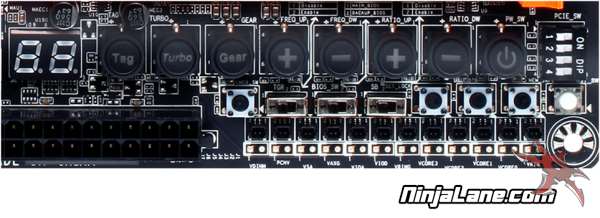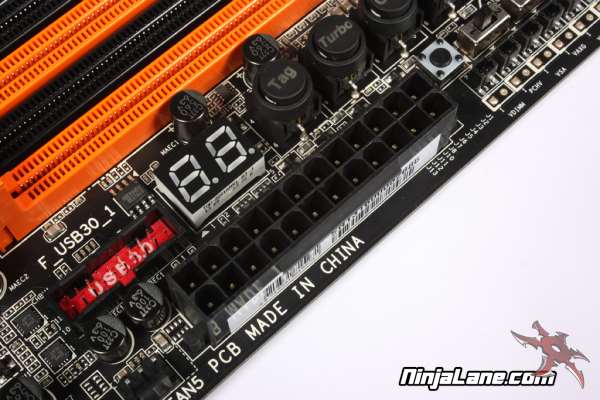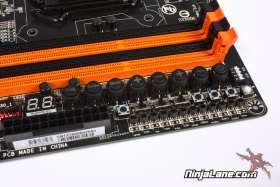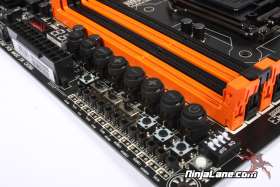Gigabyte Z87X OC Overclocking Motherboard Review
Author: Dennis Garcia
Published: Thursday, July 18, 2013
Gigabyte Hardware Overclocking Features
Onboard overclocking controls are a unique feature that many companies have experimented with. These range from simple power and reset buttons to more advanced options that will control BCLK and provide voltage readings. Very few companies have been successful putting these controls onboard and will often resort to complex software based solutions over USB or external control boards. While there is no right or wrong way to provide advanced overclocking controls we feel it is important to provide everything in one location with and intuitive interface.
Gigabyte has provided an extremely robust advanced overclocking solution that is almost too complex to explain but comes with a very simple name, OC Touch. OC Touch features a familiar power button followed by plus and minus buttons for multiplier and BCLK. The Gear button changes the stepping of the BCLK from 1 to .1. Turbo brings back memories of single button overclocking on the original IBM PC Clones and works in much the same way. Finally the Tag button is a new feature that will load custom BIOS settings after a CMOS reset.
Gigabyte has provided an extremely robust advanced overclocking solution that is almost too complex to explain but comes with a very simple name, OC Touch. OC Touch features a familiar power button followed by plus and minus buttons for multiplier and BCLK. The Gear button changes the stepping of the BCLK from 1 to .1. Turbo brings back memories of single button overclocking on the original IBM PC Clones and works in much the same way. Finally the Tag button is a new feature that will load custom BIOS settings after a CMOS reset.

Along with OC Touch you'll find specialized buttons for boot to BIOS, reset, memory safe, settings lock and clear CMOS. Along the right is a 4 gang set of PCI Express disable switches which can be helpful when running multi card benchmarks or when troubleshooting an issue with one or more video cards.
An often overlooked feature are the voltage read points, most of the time the value you set in the BIOS is carried thru and remains stable while the system is running but every once in awhile you may encounter a vDroop and need to know how much to compensate for and a voltage read point will give you that information. You have two testing methods either using the included VOM probes or surface pads.
An often overlooked feature are the voltage read points, most of the time the value you set in the BIOS is carried thru and remains stable while the system is running but every once in awhile you may encounter a vDroop and need to know how much to compensate for and a voltage read point will give you that information. You have two testing methods either using the included VOM probes or surface pads.
Finally is the slide switches, these include a BIOS Switch to boot between the BIOS chips along with a switch to disable the Gigabyte DualBIOS feature. The last switch is called OC Trigger. OC Trigger will jump between low (idle) and high (your overclock) frequencies while the system is running. This can be helpful when cooling a system for a benchmark run or when you are trying to reach 7Ghz and only have a few seconds of stability to get your validation file.
Much to our disappointment Gigabyte has moved the debug LED to the left of the OC Touch buttons and smack dab between the 24-pin power plug and memory slots. While this doesn't seem to be a huge issue it does make reading the POST codes more difficult than it should be.
Much to our disappointment Gigabyte has moved the debug LED to the left of the OC Touch buttons and smack dab between the 24-pin power plug and memory slots. While this doesn't seem to be a huge issue it does make reading the POST codes more difficult than it should be.

While onboard overclocking controls are a nice visual feature there is at least one hidden upgrade that is often overlooked on the new Z87X-OC and OC Force motherboard, solid power pins.
That's right, if you look in each of the power sockets you will see solid pins instead of the expanded metal versions common since the beginning of time. Solid pins may help with power delivery or could just be a passing fad. The jury is still out on that one.
That's right, if you look in each of the power sockets you will see solid pins instead of the expanded metal versions common since the beginning of time. Solid pins may help with power delivery or could just be a passing fad. The jury is still out on that one.



